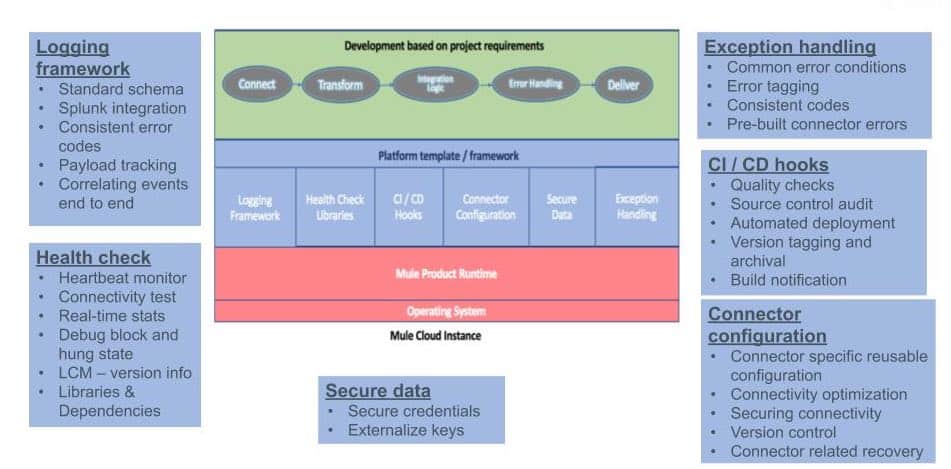Are you stuck with business as usual where you end up building solutions with a platform as a service (PaaS) for project needs? Do you want to get out of always being reactive, creating further technical debt and never able to execute the vision of building rapid solutions that would end up being assets to your organization? This is my story of how I reduced IT costs and the increased project quality at a large beverage company.
I am a proud integration veteran. From my first experience in middleware with CICS on the mainframe to managing the ever-evolving protocols in documents and transport, I have witnessed a global trend toward universal connectivity and data ubiquity. Every step the industry has taken to achieve integration with document protocols including EDI, RosettaNet, XML, and JSON along with managed file transfer, SOAP, REST, and gRPC have created more choices for solving the same problem.
Delivering API-led connectivity at a large beverage company
During my time at one of the largest beverage companies in the world, I was responsible for running their integration platform. My objective was to use the MuleSoft platform for all integration needs leveraging Mulesoft’s Anypoint Platform connectivity and rapidly deliver solutions in cloud integrating with best of breed SaaS and enterprise systems. With my experience implementing integration solutions with various technologies, I was under the impression that I could deliver successfully.
To achieve connectivity, I needed to solve 6 key challenges
I assessed the current state of integration across the organization and realized I faced six major challenges:
Challenge #1: There was a lack of understanding from both business and IT stakeholders on how API-led connectivity creates business value.
Challenge #2: Information risk management-compliant solutions cannot be implemented without intentional design for business continuity and data security.
Challenge #3: Building a delivery team with the necessary skills is harder than procuring SaaS solutions and provisioning PaaS.
Challenge #4: SaaS and PaaS do not eliminate the need for consensus on an enterprise-wide conceptual, logical, and physical data model.
Challenge #5: Operational excellence in a platform cannot happen without investment in foundational elements like logging, monitoring, auditing, and management.
Challenge #6: When optimized for monolithic solutions, delivering IT solutions with SDLC ended up costing more than non-SDLC methodologies.
I was unable to meet objectives set by my leadership on the new platform of reducing cost, increasing quality and providing rapid integration solutions. Challenges were weighing me down heavily and I wanted a cohesive actionable plan that would address the challenges.
Ignoring the challenges above would prove costly to any organization. On top of it, it creates a lot of technical debt with the new platform.
My philosophy in personal and professional career always has been to learn from others, seek help and guidance from practitioners/experts who overcame challenges. I for my part would do the same, offer guidance and help if it improves the community. This has always been my success mantra. With my exposure to maturity models and enterprise roadmaps with integration practices, I have seen first-hand how they help synthesize current state and project roadmap to align with maturity desired.
I used MuleSoft’s blueprint for IT maturity to assess the current state and build a roadmap of activities to overcome the challenges. The assessment measures organizations’ maturity across six disciplines: strategy, organization and governance, Software development life cycle (SDLC), discoverability and self-service, operations, and community and evangelism. The output of the assessment is a roadmap to improve your organization’s integration maturity across each of the six disciplines.
What I learned from the IT maturity assessment
| Output | Action |
| Readout on current state across the six disciplines mapped on a maturity model. | This helped me in communication with leadership as well as teams I was partnering with. |
| Analysis of the divergence of perspectives across various teams that participated in the survey which showed factors for prioritization. | I was able to work with other team leaders in improving the alignment. |
| List of actionable items and how they would resolve my challenges. | I identified activities that would help my goals and got buy-in from leadership. |
| Methodology to prioritize and execute activities on a timeline. | This helped me fund the initiatives with a combination of central platform funding and getting executed as part of the implementation of multiple projects. |
Using these outcomes, I brought together a new platform team
Using MuleSoft’s best practices, I brought together a Center for Enablement (C4E) to enable our organization on a set of standards. The platform team focused on:
- Using MuleSoft’s best practices to align on standards and design within my own organization.
- Creating content and assets to accelerate implementation to achieve consistency and enable reuse.
- Establishing a governance model to ensure quality and compliance.
- Providing frameworks and utilities that natively enable operations and governance.
- Allowing Leadership to set goals, gain visibility of adoption, and get platform insights.
Funding is a challenge that discourages good intention in building a platform especially when leadership does not immediately see the direct business value. I wanted the activities to be very transparent, measurable, and to show how they drove a reduction in time required to deliver IT projects, a decrease in cost of delivery, and an increase in the quality of output.
To accomplish this, I took the following steps and communicated on regular cadence to my leadership team to get their buy-in. Because of this, I was able to secure continuous funding for resources to manage the platform.
- I provided a centralized and consolidated view of all integrations currently in use and in transit, helping tie them back to the subscription cost.
- I provide insight into the adoption of various best practices such as template usage, health check, logging framework.
- I allowed for tracking the various review happening as per SDLC with the ability to track key metrics down the line.
- I tracked various KPIs that reflect the subscription optimization and best practice adherence across projects.
- I shared insights into the general health and where possible proactively alert anomalies such as lack of traffic for prolonged time periods, significantly reduced traffic, and more.
- I shared insights into the general health and where possible proactively alert anomalies such as lack of traffic for prolonged time periods, significantly reduced traffic, and more.
The activities I identified became the building blocks for our robust, scalable, and optimized platform. We were able to prove that the platform reduced delivery time from four weeks to two weeks with a template-based development approach, increased quality with automated testing frameworks, and decreased the time required to onboard new resources.
My framework to enable enterprise-wide integration standards

My team created a blueprint for our platform that was shared across multiple business units so they could leverage the standard, centrally-built foundation. As more and more artifacts were created and with discovery and reuse, the vision of reducing cost and building a network of applications was guaranteed for business.
We presented 5 key outcomes to IT and business leadership
- Business and IT stakeholders now could see value in the rapid implementation of APIs with consistent solutions built with templates.
- Information risk management-compliant solutions with intentional design in templates for business continuity and data security and applied across all solutions.
- Onboarding delivery teams on platform artifacts were much quicker as the focus was on the usage of foundational elements which reduced the work involved in each API.
- Operational excellence of platform improved with continuous investment in foundational elements like logging, monitoring, auditing, and management.
- Delivery of IT solutions ends up costing lower with increased quality.
IT leadership was able to see the results with minimal investment in building foundational elements and how rapid solutions are enabling digital transformation aligned with the business vision. IT senior leadership were always eager to share with CIO and CIO, in turn, wanted to show the success and communicate broadly to business units on how the platform is well suited to bring in the necessary digital transformation to the entire organization. This became a blueprint for other SaaS/PaaS technologies on how to onboard/to enable and gain tremendous value from the investments made.
Take your own IT maturity assessment online
I am now working for customer success with MuleSoft, helping customers with CaMA, guiding them on activities and seeing the results such as reduction of cost and increase in quality. Check out MuleSoft’s online tool to assess your own IT maturity today.









